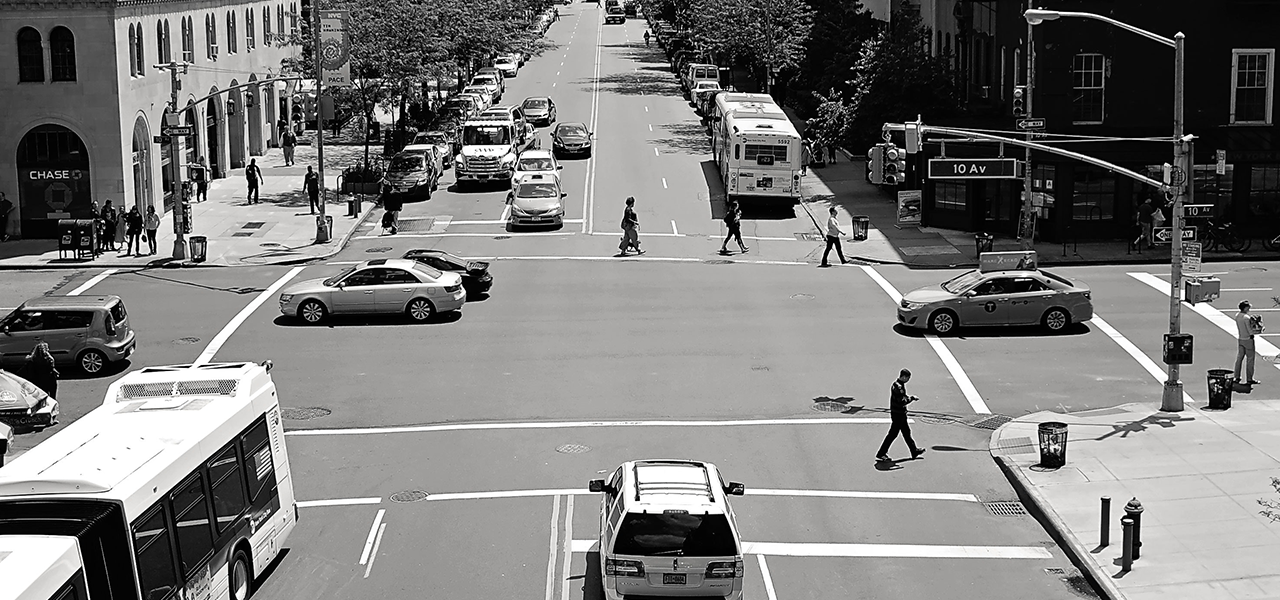
“If we, as a society, could design our traffic system from scratch, what would we want it to look like?” Johannes Himmelreich is a philosopher at the University of Stanford and works in collaboration with engineers from CARS (Center for Automotive Research at Stanford). In a recent column, he put forward this very question, whose wording casually declares a Copernican revolution among the ethical concerns linked to the development of connected and autonomous mobility.
Red light ethics
Up until now, when it came to considering moral questions around the use of autonomous vehicles, scientists have mainly referred to it as an “ethics of extremes”. And without a doubt, MIT’s Moral Machine is the most famous case. This platform presents the player with various accident scenarios, and with the help of a diagram, the player must answer questions such as the following: approaching a pedestrian crossing, your brakes fail. What should the autonomous car do?
Example: should the car swerve and crash into a concrete barrier, killing all passengers aboard (a man, his daughter and wife – who is a doctor)? Or should it continue head on and sacrifice five individuals instead (including an overweight man and a cat)? The platform aims to “gather a human perspective on moral decisions made by machine intelligence”, harking back to the age old trolley problem, that famous ethics thought experiment in which latest research actually shows doesn’t reflect accurately the decisions we would make in such a situation.
As for these tempting extreme experiments, Himmelreich is against the need for an ethic towards “mundane traffic situations”, and is more interested in equally mundane questions like, how should an autonomous car approach a red light?
Mobility, security, environment, social justice
Indeed, creating an algorithmic robotic driver in itself comes with numerous ethical dilemmas. Questions over the supposed “avoidability” of the recent deadly accident in the US involving one of Uber’s self-driving cars, obviously makes us think at first glance of the issues surrounding safety. How to solve a problem that is, a priori, unsolvable? It’s worth pointing out that, how should an autonomous car be programmed to prioritize between speed, passenger safety and the safety of other road users? After all, we could also make autonomous vehicles that drive under 20mph….
Other dilemmas are foreseeable. Each micro-decision predicted by driverless cars’ operating systems is potentially carrying a moral choice: between mobility and the environment (for example, the impact of adjusting accelerator controls on carbon emissions), or even in terms of social justice (would such driverless cars react better than humans, who leave black people waiting 32% longer on average than white people at pedestrian crossings?).
Self-driving car ethics will rely on tomorrow’s infrastructures
Himmelreich’s work has a direct impact on road infrastructure: its fuels the idea of thinking while driving and about the type of signage that we “as a society” want in the future. Because, after all, why would we still need pedestrian crossings in the future? Maybe the philosopher asked himself this question after falling for the hypnotic charm of this video on autonomous intersection management…. However, he does conclude that, with driverless cars, cities have the possibility to redesign urban traffic systems from top to bottom, and to rethink whether we really need furniture like traffic lights or pedestrian crossings after all.
NACTO is an an organization gathering a number of major North American cities and transit agencies, and they’ve outlined an urbanism utopia for the autonomous era. Amongst the expected changes towards infrastructure is the idea of freeing up a significant part of public space, but also, for example, the idea that “pedestrians could be given priority on every given space on tomorrows’ streets.” Practically speaking, it’s a utopia that must combine certain conditions: dynamic signage that interacts with vehicles (without the need to deck out city pedestrians in sensors!), automobile traffic management that’s more spaced out, or even predetermined clarification of legal responsibility in case of an accident (is it the person who built or who manages the infrastructure?). On top of all that, “the intuitive act of crossing a street directly at one’s destination could become the norm.” So no more pedestrian crossings, then? Such new issues will implicate ethicists and engineers alike, but also raise society’s choice and the “traditional” layout of public space. Again, should we prepare collectively? “The authority who is best placed to directly organize public space is the one voted for by the people who live there. It’ll be necessary to establish talks with constructors in order to anticipate, manage and guide future autonomous vehicle traffic,” remarked recently Philippe Dewost, the head of Leonard.
